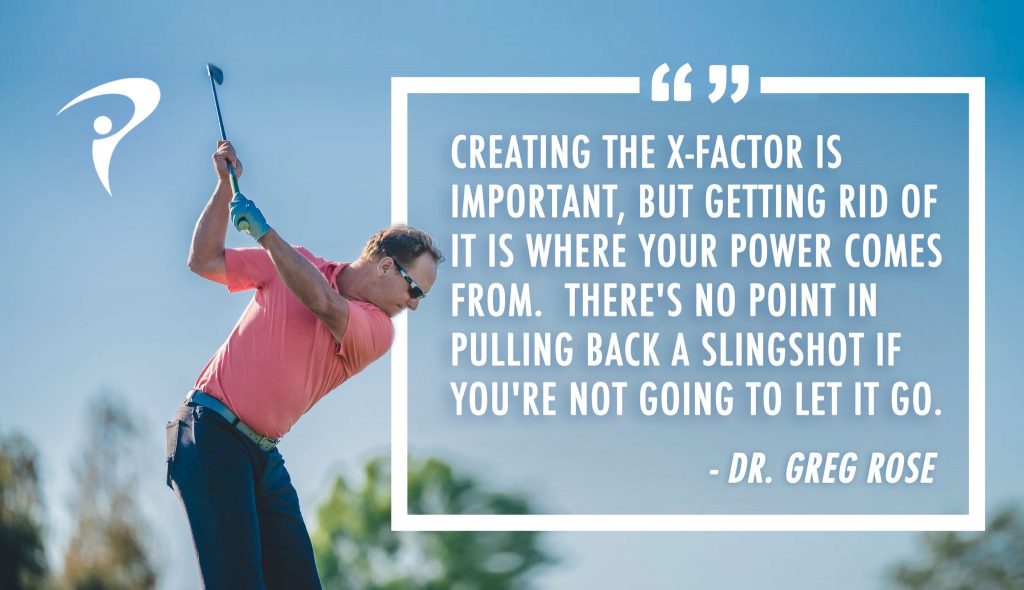This quote from Dr. Rose of the Titleist Performance Institute caught my attention. I want to help you understand the concept of getting rid of X-Factor and provide a few exercises that may help you improve your body for a more efficient and powerful golf swing.
What is X-Factor?
X-Factor is the difference between upper body and pelvis rotation at the top of the swing. For example, if you have 90 degrees of upper body rotation at the top of the swing, and 45 degrees of pelvis rotation, you’d have an X-Factor of 45 degrees.
Another element of X-Factor, called X-Factor Stretch, measures the amount of separation created in the downswing by the pelvis rotating down before the upper body. To provide an example, let’s say as you initiate your downswing, the pelvis rotates 10 degrees down before the upper body moves down. Your X-Factor Stretch would be 10 degrees.
Research has suggested that X-Factor Stretch is a stronger predictor of better golf performance than X-Factor. In other words, creating separation at the transition into the downswing is likely more important than creating separation in the backswing.
Regardless, creating X-Factor and X-Factor Stretch, or achieving muscular stretch between the pelvis and upper body, is important in creating elastic energy, which can potentially be used to create speed and power.
Getting Rid of X-Factor
Now, let me explain the concept of getting rid of X-Factor. We know that creating a stretch between the upper body and pelvis is how we create elastic energy. However, elastic energy alone isn’t going to improve your ball striking! Elastic energy means potential energy. Ultimately you need to transfer that energy through the body and club to benefit from it. This is what Dr. Rose means when he says, “There’s no point in pulling back a slingshot if you’re not going to let it go.”
So, how is elastic potential energy transferred? By getting rid of X-Factor by impact! In order for this to happen, the pelvis must be the first segment to decelerate so the upper body can “catch up” and close in. Getting rid of X-Factor and transferring energy requires stability in the lower body and core strength.
Improving the Body for Better Energy Transfer and Power
The core is responsible for absorbing and transferring the energy created by rotating and stretching the body in the golf swing. This becomes even more important at higher swing speeds, hence why core strength is essential for golfers looking for more distance.
So which core exercises are most effective for golfers? There isn’t a simple answer as all golfers have different needs, but I can show you two exercises that most golfers will benefit from.
Dead Bugs – Opposite Arm/Leg Extension For Core Strength
Golf Fitness Pro Tips:
- Keep your lower back flat, as if you’re trying to squash a bug crawling underneath it.
- Move your arms and legs at a slow controlled pace
- Only progress when you’re able to keep the lower back stable with the feet down.
- Perform 3 sets x 12 reps at the beginning of a workout or before your round of golf or practice session.
Half-Kneeling Chops For Lower Body Stability and Core Strength
Golf Fitness Pro Tips:
- Get some cushion under your knee
- Get into a proper half-kneeling position:
- Leg closest to the anchor or cable machine should be forward
- Knee of the “down leg” should be directly under the hip
- Heel of the “forward leg” should be directly under the knee
- Straight posture and long spine
- Pick a relatively light weight or resistance
- Focus on keeping the pelvis and lower body stable!
- Perform 3 sets x 12 reps in both directions as a part of your normal strength workout.
If you have any questions, you can reach me directly at [email protected]
Jason Rivkin
TPI Certified Golf Fitness Professional
If you try these exercises and you find them to be too challenging or uncomfortable, do not continue, until you have consulted with your physician. All exercises for golf should be customized to your needs after a proper evaluation.
Come In and See Us
Want to take your golf to the next level? Our FitGolf® Trainers are experts at working one-on-one with you to tailor a training program to meet the specific needs of your body and help you achieve the results you are hoping to see in your golf.
Want More Resources?
Looking for more exercise resources, blog posts or monthly golf-specific exercise content sent straight to your inbox?

